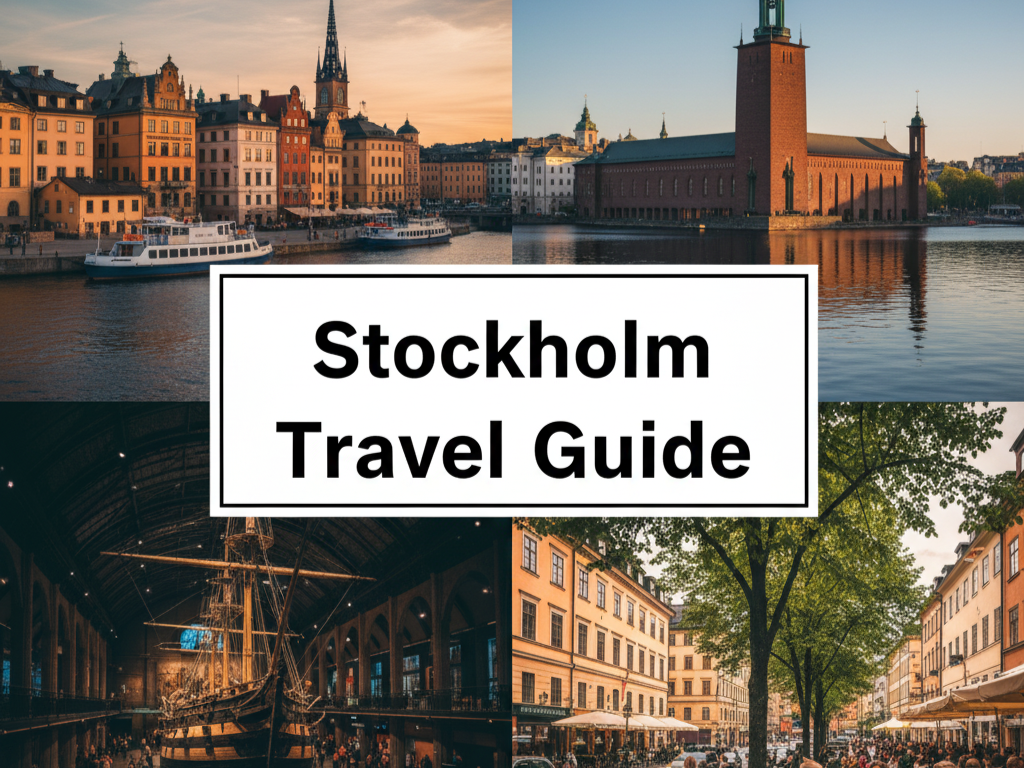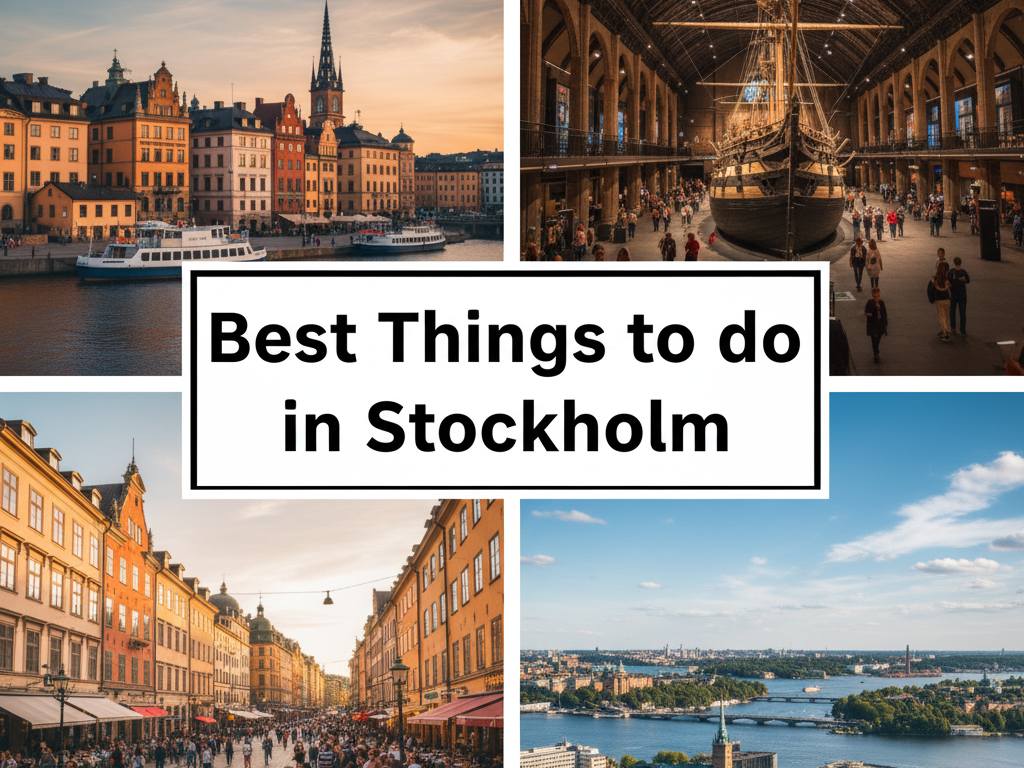Few cities in the world combine old-world charm with modern design as gracefully as Stockholm. Built across 14 islands connected by more than 50 bridges, Sweden’s capital is often called the “Venice of the North.” It’s a city where medieval cobblestone streets meet sleek architecture, and where centuries of history coexist with innovative cuisine and cutting-edge fashion. Whether you are visiting in the bright days of summer or under a soft winter snowfall, Stockholm offers a unique blend of nature, culture, and effortless Scandinavian style. This Stockholm Travel Guide covers everything you need to plan an unforgettable trip, from must-see attractions and neighborhoods to transportation, dining, and local tips that help you experience the city like a local.
Stockholm Travel Guide – Getting to Know Stockholm
Stockholm is the cultural, political, and economic heart of Sweden. The city is spread across islands on Lake Mälaren, leading into the Baltic Sea, creating stunning waterfront views almost everywhere you go. Founded in the 13th century, Stockholm has grown into one of Europe’s cleanest and most environmentally conscious capitals. It’s known for its efficient public transport, walkable streets, and vibrant atmosphere. English is widely spoken, and visitors often find locals friendly and eager to help. The city’s blend of water, green parks, and historical architecture makes it feel both peaceful and cosmopolitan. Each island has its own personality, from the medieval alleys of Gamla Stan to the hip cafes and boutiques of Södermalm.
Stockholm Travel Guide – How to Get Around
Stockholm is one of the easiest cities in Europe to navigate. The SL public transport system covers buses, metro lines, ferries, and commuter trains, all accessible with one card or mobile ticket. The Tunnelbana, Stockholm’s metro, is not just a means of transportation; it’s an underground art gallery. More than 90 stations are decorated with murals, sculptures, and mosaics, making every ride a visual experience.
For shorter distances, walking is a pleasure. Many neighborhoods are compact and full of pedestrian-friendly streets. Biking is another excellent option; the city has dedicated bike lanes and rental stations everywhere. Ferries connect major islands like Djurgården, Skeppsholmen, and Södermalm, offering scenic rides across the waterways. In summer, a ferry ride at sunset is one of the most beautiful ways to see Stockholm’s skyline.
Stockholm Travel Guide – Where to Stay in Stockholm
Stockholm offers a wide range of accommodations for every budget and travel style.
- Gamla Stan (Old Town): Perfect for first-time visitors. You’ll be surrounded by narrow cobblestone streets, colorful 17th-century buildings, and historic charm. Staying here means you can walk to major attractions like the Royal Palace and Stortorget Square.
- Södermalm: Known for its artistic vibe, vintage stores, and trendy cafes. It’s ideal for travelers who love a local atmosphere and nightlife.
- Norrmalm: The modern center of Stockholm with plenty of hotels, shopping, and easy transport connections.
- Östermalm: Elegant and upscale, this area is filled with fine dining restaurants, luxury boutiques, and the famous Östermalm Market Hall.
- Djurgården: Surrounded by parks and museums, this island offers a peaceful setting close to family attractions.
Hotels in Stockholm tend to be modern, clean, and stylish, often featuring minimalist Scandinavian design. During the summer, it’s best to book early, as the city becomes a popular destination for both European and international travelers.
Stockholm Travel Guide – Top Attractions
Gamla Stan
The heart of Stockholm, Gamla Stan is where the city began in the 13th century. Stroll through narrow alleys, admire colorful façades, and stop at cozy cafes for fika, the Swedish tradition of coffee and cake. Don’t miss the Royal Palace, one of Europe’s largest palaces, where you can watch the Changing of the Guard or explore the Royal Apartments and the Treasury. Nearby, Storkyrkan Cathedral and Nobel Prize Museum are must-visit for history lovers.
Djurgården Island
A green oasis in the middle of the city, Djurgården is home to some of Stockholm’s best museums and family attractions. The Vasa Museum displays a perfectly preserved 17th-century warship that sank on its maiden voyage and was recovered centuries later. Just next door, ABBA The Museum celebrates Sweden’s most famous pop group with interactive exhibits. Families will love Skansen, the world’s oldest open-air museum showcasing Swedish traditions, crafts, and even live animals native to Scandinavia.
Södermalm
If you want to experience Stockholm’s modern culture, Södermalm is the place to go. The area is filled with independent boutiques, art galleries, and some of the city’s best cafes. Climb up to Monteliusvägen for one of the best panoramic views of the city. In the evening, explore the bars and restaurants along Hornsgatan and Nytorget, where locals gather after work.
Stockholm Archipelago
Just a short ferry ride away lies the Stockholm Archipelago, a breathtaking collection of over 30,000 islands stretching into the Baltic Sea. You can take day trips to nearby islands like Vaxholm or Grinda, or plan a longer cruise to explore more remote areas. Each island offers something unique, from sandy beaches to forest trails and seaside cafes. Summer is the perfect time to experience the archipelago, but winter trips bring a quiet, frozen beauty of their own.
City Hall (Stadshuset)
One of Stockholm’s most iconic buildings, City Hall stands proudly by the water on Kungsholmen Island. It’s famous as the venue for the Nobel Prize banquet and offers guided tours that showcase its grand halls and mosaics. Climb the tower for a panoramic view of the city’s skyline and surrounding waterways, it’s especially beautiful at sunset.
You can also check our article about the best things to do in Stockholm
Stockholm Travel Guide – Food and Drinks
Swedish cuisine is simple, fresh, and focused on quality ingredients. Start your day with fika, a cultural ritual of coffee and a cinnamon bun. For lunch, locals often enjoy husmanskost, traditional comfort dishes like meatballs with lingonberry sauce or creamy salmon stew. Stockholm’s dining scene is diverse, with everything from Michelin-starred restaurants to street food markets.
Visit Östermalms Saluhall, a historic indoor market where you can sample cheeses, smoked fish, and cured meats. For a trendy evening out, Södermalm and Norrmalm are full of stylish restaurants and bars serving Nordic-inspired dishes. If you’re a fan of seafood, don’t miss Blå Porten on Djurgården or Sturehof in central Stockholm. Vegetarian and vegan options are widely available, reflecting Sweden’s sustainability-minded food culture.
Seafood is exceptional in Stockholm. Whether it’s herring, oysters, or smoked salmon, everything tastes incredibly fresh. For a unique experience, head to Östermalms Saluhall, an indoor food market that’s been serving locals since the 1880s. You can sample delicacies like cured fish, cheese, and reindeer meat while chatting with local vendors.
Best Time to Visit Stockholm
Stockholm changes character with the seasons. Summer (June to August) is the most popular time to visit, with long daylight hours, outdoor festivals, and warm weather perfect for exploring parks and waterfronts. Spring (April to May) brings blooming cherry blossoms and fewer tourists, making it a great time for sightseeing. Autumn (September to October) offers cooler air, golden leaves, and cozy evenings perfect for enjoying candle-lit cafes. Winter (November to February) transforms the city into a snowy wonderland, complete with Christmas markets, ice skating, and a magical atmosphere, though daylight is limited to a few hours per day.
Practical Tips for Visitors
- Currency: The Swedish krona (SEK). Credit cards are accepted almost everywhere, and many places are cashless.
- Language: Swedish is the official language, but English is widely spoken.
- Tipping: Service charges are usually included, but rounding up the bill or leaving 5–10% is appreciated.
- Water: Tap water is perfectly safe and among the cleanest in the world.
- Wi-Fi: Free Wi-Fi is available in most hotels, cafes, and public areas.
For a smoother trip, download the SL app for public transport, and consider buying a Stockholm Pass for discounts on attractions and unlimited travel.
Final Thoughts
Stockholm is a city that manages to be both old and new, natural and urban, traditional and modern. It’s a place where you can visit world-class museums in the morning, enjoy a waterfront lunch, and wander through centuries-old streets in the afternoon. The blend of design, culture, and natural beauty makes Stockholm one of Europe’s most captivating capitals. Whether you’re here for a weekend or a longer stay, you’ll find that the city invites you to slow down, explore thoughtfully, and savor the Scandinavian way of life.






Leave a Reply